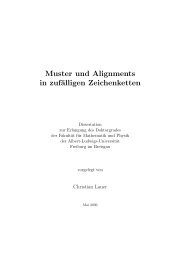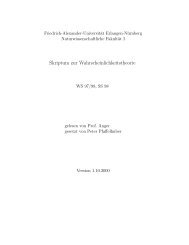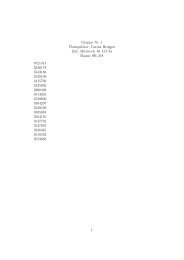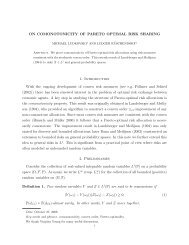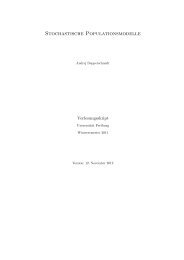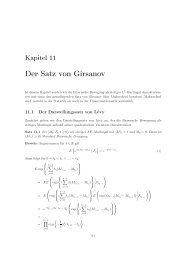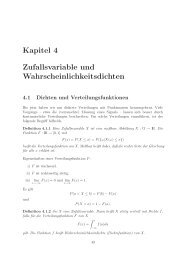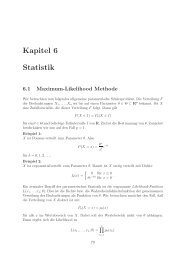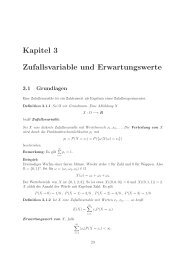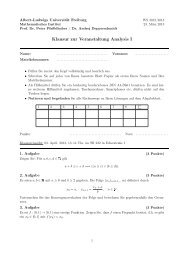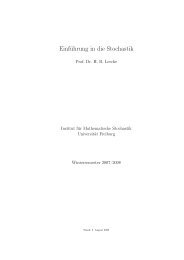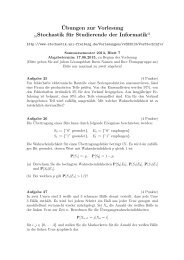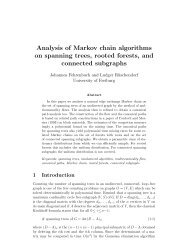On the Internal Path Length of dâdimensional Quad Trees
On the Internal Path Length of dâdimensional Quad Trees
On the Internal Path Length of dâdimensional Quad Trees
Create successful ePaper yourself
Turn your PDF publications into a flip-book with our unique Google optimized e-Paper software.
Corollary 4.5 Let Y n denote <strong>the</strong> internal path length <strong>of</strong> a d–dimensional<br />
quad tree. Then for any λ, ɛ > 0 <strong>the</strong>re exists C λ,ɛ > 0 such that for all<br />
n ∈ IN<br />
Equivalently<br />
for all k ∈ IN.<br />
IP (|Y n − IEY n | ≥ ɛIEY n ) ≤ C λ,ɛ n −(2λɛ)/d .<br />
IP (|Y n − IEY n | ≥ ɛIEY n ) = O(n −k )<br />
5 Extension to a general split tree model<br />
Several fur<strong>the</strong>r random trees lead to a type <strong>of</strong> recursion for <strong>the</strong> internal path<br />
length similar to <strong>the</strong> recursion (12) for <strong>the</strong> random quad tree. For o<strong>the</strong>r<br />
characteristic quantities as <strong>the</strong> depth <strong>of</strong> insertion <strong>of</strong> a key or <strong>the</strong> height <strong>of</strong><br />
a tree Devroye [4] gave a uniform treatment for a ra<strong>the</strong>r general model <strong>of</strong><br />
a random tree which he calls <strong>the</strong> random split tree. This model contains<br />
many common trees, e.g. <strong>the</strong> random binary search tree, <strong>the</strong> m-ary search<br />
tree, <strong>the</strong> random quad tree . . . A related model for a general class <strong>of</strong> random<br />
trees is discussed in Aldous [1]. Devroye’s random split tree is determined<br />
by a fixed branch factor b > 0, <strong>the</strong> number s 0 ≥ 0 <strong>of</strong> keys contained in an<br />
internal node (usually s 0 = 1, but for <strong>the</strong> m-ary tree we have s 0 = m − 1<br />
keys in an internal node; in <strong>the</strong> following we assume s 0 ≥ 1) and a split<br />
vector V = (V 1 , . . . , V b ) <strong>of</strong> random probabilities, ∑ V k = 1, V k ≥ 0 which<br />
controls <strong>the</strong> splitting process during <strong>the</strong> insertions <strong>of</strong> keys independently at<br />
each node toge<strong>the</strong>r with some fur<strong>the</strong>r parameters. For details see Devroye [4].<br />
For such a general type <strong>of</strong> random split tree <strong>the</strong> internal path length Y n<br />
satisfies <strong>the</strong> recursion<br />
Y n D =<br />
b∑<br />
k=1<br />
Y (k) + n (50)<br />
I (n)<br />
k<br />
where (Y (k)<br />
i ) are independent copies <strong>of</strong> Y i , {(Y (k)<br />
i ), k = 1, . . . , b}, I (n) are<br />
independent and I (n) (<strong>the</strong> vector <strong>of</strong> <strong>the</strong> cardinalities <strong>of</strong> <strong>the</strong> subtrees) is conditionally<br />
given V = (v 1 , . . . , v b ) multinomial M(n−s 0 , v 1 , . . . , v b ) distributed.<br />
Here V is <strong>the</strong> split vector controlling <strong>the</strong> splitting process at <strong>the</strong> root. Now<br />
16



